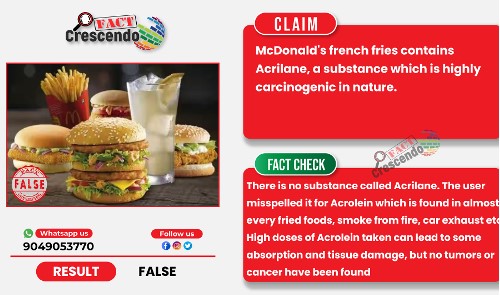
McDonalds has been a victim of many social media rumors from time to time. Consumers had previously raised many questions on the safety, production process, types of ingredients, and health issues related to the consumptions of the food produced by the company.
A recent social media post has targeted the company saying the famous french fries made by McDonalds contains Acrilane, a substance that is also used in cigarettes which is carcinogenic in nature.
However, Fact Crescendo found that there is no substance called Acrilane. The user must have misspelled Acrolein as Acrilane. Acrolein is a product which can be found in fried food items, car exhaust or smoke from fire etc. High doses of Acrolein taken orally can lead to some absorption and tissue damage, but no tumors or cancer have been found
What’s the claim?
A user wrote, “One large McDonald’s french fry from McDonald’s has the same amount of Acrilane as a pack of cigarettes. Acrilane is the most carcinogenic ingredient in cigarettes. McDonald’s french fries are harvested from potatoes that are sprayed with a pesticide that is so harmful to humans that the farmers must let it sit for four days before they can safely handle it.”
Fact Check-
A keyword search revealed that cigarettes do not have Acrilane but a substance called Acrolein. The user must have misspelled Acrolein for Acrilane.
What is Acrolein?
According to the CDC, Acrolein, also known as propenal or acrylaldehyde, is a colorless or yellow liquid and has a strong odor. This substance generally formed from burning tobacco, wood, plastics, gasoline, and paraffin wax. Cooking fats and oils at high temperatures can also release acrolein.
Acrolein can enter the environment from sources like car exhaust, smoke from fires or cigarettes, and factories that make or use it. It can also get into water when used to control weeds, algae, bacteria, or small water animals. In the air, acrolein breaks down quickly, with about half disappearing within a day due to reactions with sunlight and other chemicals. It also evaporates quickly from soil and water. It doesn’t move through soil to reach groundwater, and it doesn’t build up in plants or animals.
Breathing air with acrolein can make your eyes feel irritated and watery. It can also irritate your nose and throat and make you breathe more slowly, but these effects usually go away once you stop breathing the air with acrolein.
In studies with animals, breathing acrolein for a short time irritated their nose and throat and slowed their breathing. It also made it harder for them to fight infections. Some animals blinked or closed their eyes when exposed to acrolein. When animals ate acrolein, it irritated and inflamed their stomach lining and made some of them throw up.
A study conducted by the United States Environmental Protection Agency (EPA) revealed that there isn’t enough data to determine if acrolein causes cancer in humans through ingestion or inhalation, and existing animal studies don’t provide clear evidence of its carcinogenic potential.
Findings of another study says Acrolein can cause DNA changes and mutations in some cell types, including Drosophila and certain microorganisms, but there’s limited information about its effects on normal mammalian cells. It mainly stays in the upper respiratory tract when inhaled because it is very reactive. Some studies suggest that high doses taken orally can lead to some absorption and tissue damage, but no tumors have been found in the respiratory tract, skin, or digestive system. Research shows that acrolein doesn’t spread much to other tissues in the body. Because of its reactive nature and limited distribution, it’s unlikely that acrolein can reach enough concentration in the body to cause cancer in mammals.
According to the National Library of Medicine (NIH), even frying food at home can produce acrolein. A study looked at how acrolein is released when frying in different oils like soybean, corn, canola, sunflower, and palm oil. Researchers developed a method to measure acrolein in French fries using a technique called SPME. They found that acrolein levels changed depending on the type of oil used and the frying time. Potatoes fried in soybean oil had the lowest acrolein levels. Shoestring fries had less acrolein than thicker potato chips and regular French fries because they have more surface area compared to their volume.
Conclusion:
Fact Crescendo found that there is no substance called Acrilane. The user must have misspelled Acrolein as Acrilane. Acrolein is a product which can be found in fried food items, car exhaust or smoke from fire etc. High doses of Acrolein taken orally can lead to some absorption and tissue damage, but no tumors or cancer have been found. Research showed that it does not spread much to surrounding tissues.


